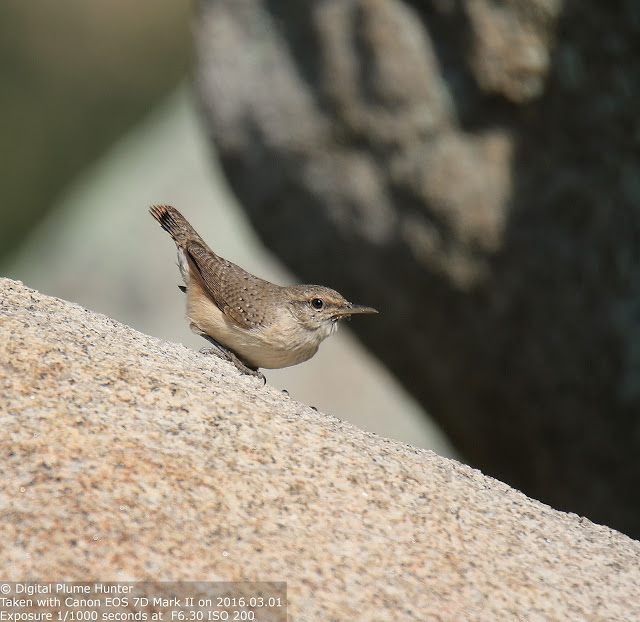[California. March 2016]
From our earlier post on hugely powerful eagles and hawks, we turn our attention to the other end of the avian spectrum -- the tiny and diminutive -- delightful and distinctive species that while small in dimension are decidedly grand on character.
Surely, every serious birder is familiar with the family of Tits and the family of Wrens. The former, known as the Paridae family, has scores of species that are found on every inhabited continent excepting S. America and Australia. On the other hand, the Wren family or the Troglodytidae comprise about 80 species globally -- most of them found in the New World and 10 of them can be found right here in the US. And, while 10 may not sound like a whole lot, keep in mind that the whole of Europe and Asia have just a single wren species to enjoy. The situation is a bit reversed on the Paridae front, with the majority of species found in the Old World and only a dozen species of Tits found in the US.
We lead, however, with the Wrentit -- an enigmatic songbird that despite its moniker, is neither wren nor tit:
The Wrentit has been a taxonomic nomad -- like a ship without a home port, it has been classified at various times under the following taxa:
- The Chamaeidae -- the Wrentit's own monotypic family
- The Aegithalidae -- with the long-tailed tits
- The Paridae -- with the true tits
- The Sylviidae -- with the Old World warblers
- The Timaliidae -- with the Old World babblers
The composite looks of the Wrentit don't help either -- it certainly has the long tail of the long-tailed tits; the overall body shape of a babbler; the coloration of a wren; the bright eyes of a bushtit and the bill of a warbler.
Surely, this
is a species that exists to confound and defy our understanding of
taxonomy. Its ambiguous characteristics are a slap in the face of
ornithologists who are generally accustomed to having species fit neatly in their vast system of classification!
 |
| Wrentit seen at Ramona Grasslands, San Diego County |
Currently, the Wrentit is placed with the Old World Warblers; but, regardless of where it is classified, this shy and sedentary species needs to be on every birder's lifelist for the sheer aura of mystery regarding its taxonomic origins.
The next songbird, seen at Ramona Grasslands, presents no such mystery -- it is decidedly a wren:
Of the 10 wrens in the US, the Rock Wren is our palest. Seen in surroundings befitting its moniker, it is uncanny how well the wren's color and plumage-pattern blend in with the grain of its rocky perch.
 |
| Rock Wren seen at Ramona Grasslands |
This Western wren is an accomplished songster and as befits a denizen of dry, rocky habitat, the Rock Wren never needs to drink water.
Just like the Rock Wren, the Oak Titmouse (a member of the Paridae or true tits) is also perfectly adapted to its environment -- in this case, the dry oak-woods habitat of the West.
 |
| Oak Titmouse seen at Cuesta Park, Mountain View, CA |
Oak Titmouse is a plain grey-brown colored tit -- small wonder that it was earlier lumped with the Juniper Titmouse into a single species known unimaginatively as simply "Plain Titmouse".
We end with the only member of the Aegithalidae, or long-tailed tit family, in the US -- the Bushtit:
 |
| Bushtit seen at Ramona Grasslands |
 |
| Bushtit seen at Cuesta Park |
These tiny, energetic songbirds are commonly seen in the West and have been featured in this blog before as observed in California and Texas.
Compound bird names such as Wrentit, Hawk-Owl, Lark Sparrow, Sparrow-Lark, Magpie Lark, etc., remind us of a small number of species that are so enigmatic that they excite our curiosity endlessly for possessing a blend of seemingly unrelated qualities sourced from different bird families. And, the incomparable Wrentit of the West, not related to any other North American bird family, is a great example of precisely such a bird.

















































